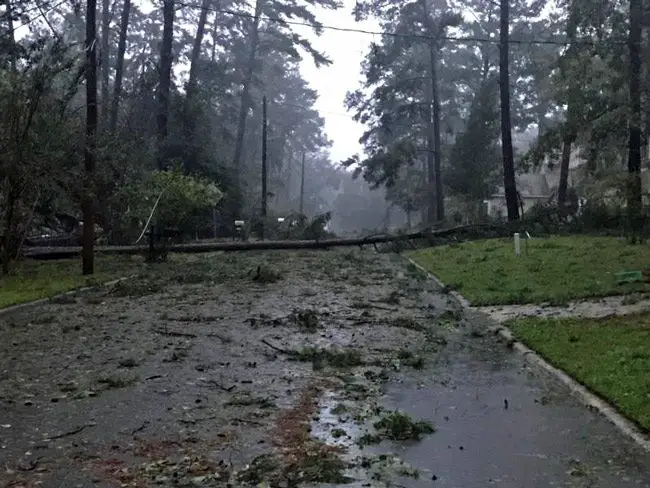
More than 400,000 utility customers remained without power Thursday morning as thousands of rescue and utility crew members spread out across coastal and rural Panhandle communities to respond to the devastation inflicted by Hurricane Michael.
Gulf Power, which provides electricity in hard-hit Bay County, anticipates people in the impacted areas could be without power for weeks as the utility rebuilds parts of its system.
Gov. Rick Scott called the destruction from Wednesday’s storm “unimaginable,” as “homes are gone, businesses are gone.”
A state emergency-management official said all hospitals in the impacted region have reported some form of “critical failure” — water and sewage problems or infrastructure issues such as crumbling walls — that required patients to be relocated and medical field hospitals to be set up.
The official said that after Hurricane Irma in September 2017, a field hospital was required in the Florida Keys for a year, and similar situations may be required with Michael.
Similar issues were arising at nursing homes, and crews were flying in supplies to Florida State Hospital at Chattahoochee, which serves patients with mental illness.
Meanwhile, the state is expecting a surge in humanitarian needs, from a lack of food and water to housing.
Scott was set to travel Thursday afternoon with the Florida National Guard to Panama City and Mexico Beach, where Michael came ashore midday Wednesday with 155 mph maximum sustained winds, the strongest ever recorded in the region.
Scott, who expressed frustration about people dismissing evacuation orders on Tuesday as Michael rapidly grew into a Category 4 storm, told evacuees not to return home as roads remain closed by flooding, downed trees and power lines.
“It’s going to take some time to survey and clear all the roads,” Scott said.
U.S. Sen. Marco Rubio, R-Fla., tweeted late Thursday morning that President Donald Trump granted a request for federal assistance for 14 counties: Bay, Calhoun, Franklin, Gadsden, Gulf, Hamilton, Jackson, Jefferson, Leon, Liberty, Madison, Suwannee, Taylor and Wakulla.
Scott said he talked to Trump early Thursday.
“He is committed to making every federal resource available to help the recovery,” Scott said.
In a letter to Trump on Wednesday requesting assistance, Scott wrote that the state had already spent close to $40 million on its response.
The Florida National Guard has deployed 3,500 members for search-and-rescue and humanitarian aid, with assistance from National Guard units from as far away as New York and Kansas. The Florida Highway Patrol has 450 troopers working in the Panhandle, while 150 Fish and Wildlife Conservation Commission officers are conducting rescue missions.
Search teams — working by air, boat and on the ground — have entered Panama City, Mexico Beach, Alligator Point, Eastpoint, St. George Island and Apalachicola. The U.S. Coast Guard ran 10 rescue missions into the region Wednesday night.
The Red Cross is bringing in 500 disaster relief workers.
More than 5,000 people were in 34 shelters that have been opened across the region.
Scott said one benefit of the rapidly moving Michael was that it hit during the day and was out of the state before sunset.
More than 19,000 utility workers from companies in Florida and across the country have started assessing the damages.
The Division of Emergency Management reported 400,666 customers of Gulf Power, Duke Energy and a number of smaller utilities were without power Thursday morning.
Pensacola-based Gulf Power, which reported some 120,000 customers were in the dark at one point, said progress was made in its westernmost regions, but the hardest-hit areas may take weeks to rebuild.
“The Gulf Power system held strong from Pensacola to Fort Walton Beach — a testament to the investments we’ve made to harden our infrastructure,” Gulf Power spokesman Jeff Rogers said in a statement. “But the hardest hit areas around Panama City may need to be rebuilt from the ground up.”
Bay County, which includes Panama City and Tyndall Air Force Base, was 98 percent without power Thursday morning, according to the state Division of Emergency Management.
Calhoun, Gadsden and Jackson counties, which are north of Bay County, were 100 percent without power. Gulf and Franklin counties, which are on the coast, and Holmes County, which is to the north, were all more than 90 percent without power.
The storm forced the closure of Interstate 10 west of Tallahassee, requiring some rescue crews to take alternate routes west from staging areas.
Although Tallahassee avoided a direct hit from the Category 4 storm, Mayor Andrew Gillum said on Facebook that “our community has been pretty significantly impacted.” He said 110,000 residences and businesses were without power Thursday, morning, representing about 90 percent of the customers served by the city’s electric service.
In addition, Gillum said the storm knocked out one of the city’s sewage systems, including the backup power source.
By comparison, about 75,000 customers lost power during Hurricane Hermine, which struck Tallahassee in 2016, said Gillum, the Democratic candidate for governor.
–Jim Turner and Lloyd Dunkelberger, News Service of Florida





























Richard says
This hurricane which was only 2 mph away form being a CAT 5 surely could be called a Cat 5 in that the wind gusts were well into the CAT 5 category. My heart goes out to everyone affected as I know how I felt when Flagler Beach had been hit twice in two years with first Matthew and then Irma and they were not even close to the same intensity. This should be a wake-up call that if one of that intensity were to ever hit the Atlantic side of Florida, prepare your property as best as you can then get the hell out of town well in advance of landfall.
tulip says
Thank you Pierre for putting up the video. It was awful to see the pics on tv, but when clicked on the video, put it on full screen then it became really up close and personal. I like the video better than tv because I could pause it when I wanted to, which really gave me a longer chance to look at the full surroundings and visually absorb the horrific damage., I also discovered that when the video ends, don’t click it off because another one comes on in a few seconds.
My heart goes out to those people and makes me appreciate my intact home more and puts things in perspective about how much we all complain about minor things and get too upset about politics, when those people and others that have suffered the same thing actually have life changing things to worry about and to put their lives back together.
gmath55 says
With a HD DVR you can record, pause, and play the video on TV as many times as you wish.
snapperhead says
Just another reason i’m glad my home is on the market. Between the close calls the last couple years, incompetent local government and increasing costs I look forward to seeing Yawn Coast in the rear view mirror.
atilla says
I think stick built home are more at danger when this situation occurs. What do you folks think?
Richard says
It really has to do more with the roof I would think. If the roof goes then lots of damage will happen regardless of whether the sides are stick or block/stucco.
REnPC says
When a storm of this strength makes landfall there is little difference between CBS and Frame when it comes down to damage.The walls may still stand but the damage will be done. Remember that roof trusses are all 2x4s on both types of homes. I have seen barrel tile roofs blast through concrete block walls. I have seen plywood pierce palm trees. The best thing you can have when faced with a storm of this power is good insurance and patience. Hang in there Panhandle, this too will pass.